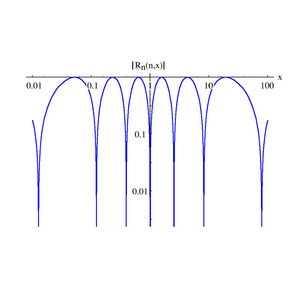Chebyshev rational functions
From HandWiki
In mathematics, the Chebyshev rational functions are a sequence of functions which are both rational and orthogonal. They are named after Pafnuty Chebyshev. A rational Chebyshev function of degree n is defined as:
- [math]\displaystyle{ R_n(x)\ \stackrel{\mathrm{def}}{=}\ T_n\left(\frac{x-1}{x+1}\right) }[/math]
where Tn(x) is a Chebyshev polynomial of the first kind.
Properties
Many properties can be derived from the properties of the Chebyshev polynomials of the first kind. Other properties are unique to the functions themselves.
Recursion
- [math]\displaystyle{ R_{n+1}(x)=2\left(\frac{x-1}{x+1}\right)R_{n}(x)-R_{n-1}(x)\quad\text{for}\,n\ge 1 }[/math]
Differential equations
- [math]\displaystyle{ (x+1)^2R_n(x)=\frac{1}{n+1}\frac{\mathrm{d}}{\mathrm{d}x}R_{n+1}(x)-\frac{1}{n-1}\frac{\mathrm{d}}{\mathrm{d}x}R_{n-1}(x) \quad \text{for } n\ge 2 }[/math]
- [math]\displaystyle{ (x+1)^2x\frac{\mathrm{d}^2}{\mathrm{d}x^2}R_n(x)+\frac{(3x+1)(x+1)}{2}\frac{\mathrm{d}}{\mathrm{d}x}R_n(x)+n^2R_{n}(x) = 0 }[/math]
Orthogonality

Plot of the absolute value of the seventh-order (n = 7) Chebyshev rational function for 0.01 ≤ x ≤ 100. Note that there are n zeroes arranged symmetrically about x = 1 and if x0 is a zero, then 1/x0 is a zero as well. The maximum value between the zeros is unity. These properties hold for all orders.
Defining:
- [math]\displaystyle{ \omega(x) \ \stackrel{\mathrm{def}}{=}\ \frac{1}{(x+1)\sqrt{x}} }[/math]
The orthogonality of the Chebyshev rational functions may be written:
- [math]\displaystyle{ \int_{0}^\infty R_m(x)\,R_n(x)\,\omega(x)\,\mathrm{d}x=\frac{\pi c_n}{2}\delta_{nm} }[/math]
where cn = 2 for n = 0 and cn = 1 for n ≥ 1; δnm is the Kronecker delta function.
Expansion of an arbitrary function
For an arbitrary function f(x) ∈ L2ω the orthogonality relationship can be used to expand f(x):
- [math]\displaystyle{ f(x)=\sum_{n=0}^\infty F_n R_n(x) }[/math]
where
- [math]\displaystyle{ F_n=\frac{2}{c_n\pi}\int_{0}^\infty f(x)R_n(x)\omega(x)\,\mathrm{d}x. }[/math]
Particular values
- [math]\displaystyle{ \begin{align} R_0(x)&=1\\ R_1(x)&=\frac{x-1}{x+1}\\ R_2(x)&=\frac{x^2-6x+1}{(x+1)^2}\\ R_3(x)&=\frac{x^3-15x^2+15x-1}{(x+1)^3}\\ R_4(x)&=\frac{x^4-28x^3+70x^2-28x+1}{(x+1)^4}\\ R_n(x)&=(x+1)^{-n}\sum_{m=0}^{n} (-1)^m\binom{2n}{2m}x^{n-m} \end{align} }[/math]
Partial fraction expansion
- [math]\displaystyle{ R_n(x)=\sum_{m=0}^{n} \frac{(m!)^2}{(2m)!}\binom{n+m-1}{m}\binom{n}{m}\frac{(-4)^m}{(x+1)^m} }[/math]
References
- Guo, Ben-Yu; Shen, Jie; Wang, Zhong-Qing (2002). "Chebyshev rational spectral and pseudospectral methods on a semi-infinite interval". Int. J. Numer. Methods Eng. 53 (1): 65–84. doi:10.1002/nme.392. Bibcode: 2002IJNME..53...65G. http://www.math.purdue.edu/~shen/pub/GSW_IJNME02.pdf. Retrieved 2006-07-25.
 |


